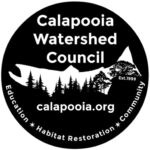
Invasive Species Control
The watershed council has taken a lead role in the treatment of early threat invasive weed species along our streams, with a focus on the mainstem Calapooia.
System-wide outreach has occurred for invasive weed control with hundreds of landowners providing permission for weed inventory and treatment. To-date, target species have included Japanese knotweed, false brome and English ivy.
Noxious weeds costs our local and state governments many millions of dollars every year, not to mention moderate to extreme degradation of property function in our basin that is 94% privately owned. By uniting on this serious threat, the watershed council can continue to provide education, outreach, assessment, and often times necessary treatment.

The watershed council has surveyed and treated the entire mainstem Calapooia for Japanese knotweed annually since 2006. The council and its partners have unfortunately relinquished funding and treatment of false brome unless found to exist at current projects sites because of its widespread infestation in our headwaters and the basins to the south and north of the Calapooia. Every stream restoration project site, whether fish passage, instream habitat or buffers, experiences aggressive noxious weed control as directed by our staff.
The rapid expansion of weedy plant species threatens our goal, because these invasive plants can dominate and often cause permanent damage to natural plant communities. Acres of once healthy, productive forestlands and riparian areas have been overrun by noxious or invasive weeds. Damage to streamside habitats is particularly detrimental for salmon, which depend on shaded, winding streams with adequate food sources.
the problem with
Invasive weeds
1
Destroy wildlife habitat
2
Reduce opportunities for hunting, fishing, camping and other recreational activities
3
Displace many Threatened and Endangered Species
4
Reduce plant and animal diversity because of weed monocultures-single plat species that over run all others in an area
5
Disrupt waterfowl and neo-tropical migratory bird flight patterns and nesting habitats
6
Cost millions of dollars in treatment and loss of productivity to private land owners
Click through our gallery to learn more about identifying, removing and replacing common invasive plant species.

invasive species control
The Emerald Ash Borer (EAB) aka “The Green Menace” is a very small but very destructive beetle. Metallic green in color, its slender body measures 1/2-inch long and 1/8-inch wide. The average adult beetle can fit easily on a penny.
invasive species control
Jumping worms (unlike earthworms or nightcrawlers)have a negative impact on soil. Over time, soil turns into coffee ground-like granules which then aggregate and harden, which repels water. This creates a more porous soil, reducing moisture content

You ask, we answer
The term “weed” means different things to different people. In the broadest sense, it is any plant growing where it is not wanted. Weeds can be native or non-native, invasive or non invasive, and noxious or not noxious. Legally, a noxious weed is any plant designated by a Federal, State or county government as injurious to public health, agriculture, recreation, wildlife or property. (Sheley, Petroff, and Borman, 1999) A noxious weed is also commonly defined as a plant that grows out of place (i.e., a rose can be a weed in a wheat field) and is “competitive, persistent, and pernicious.” (James, et al, 1991).
No. Invasive plants include not only noxious weeds, but also other plants that are not native to this country. Plants are considered invasive if they have been introduced into an environment where they did not evolve. As a result, they usually have no natural enemies to limit their reproduction and spread (Westbrooks, 1998). Some invasive plants can produce significant changes to vegetation, composition, structure, or ecosystem function. (Cronk and Fuller, 1995).
–Above content adapted from the Bureau of Land Management, including references cited therein.
SOLVE Oregon is a great resource to help with information and reporting.
The National Wildlife Federation has a great introduction to invasive species.
Let’s Pull Together is an organization that organizes annual invasive removal volunteer projects in Central and Southern Oregon.
The Oregon Department of Agriculture’s Noxious Weed Program has good information on invasive plants including profiles of the most common invaders.
Oregon Invasive Species Online Hotline
Oregon State University Extension Service’s publication Invasive Plants and your Streamside Garden (PDF, 200 KB)
Oregon State University Extension Catalog for Weeds and Invasive Species
GardenSmart Oregon – Downloadable PDF Booklet
Itegrated Pest Management Guide for Common Weed Management
Green Street Stewards Plant Identification Guide
Metro Oregon’s Native Plants for Willamette Valley Yards

Share this:
- Click to share on Twitter (Opens in new window)
- Click to share on Facebook (Opens in new window)
- Click to share on Pinterest (Opens in new window)
- Click to share on Reddit (Opens in new window)
- Click to share on WhatsApp (Opens in new window)
- Click to print (Opens in new window)
- Click to email a link to a friend (Opens in new window)















